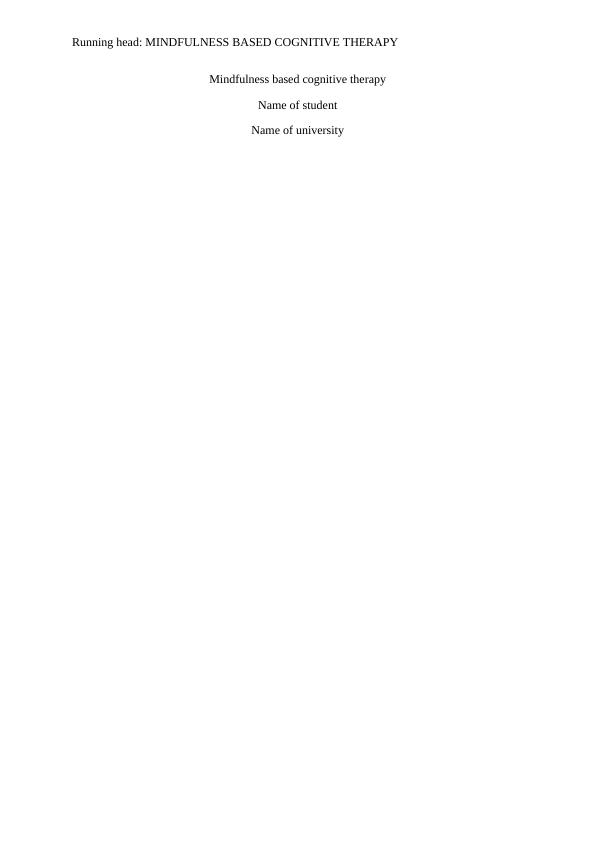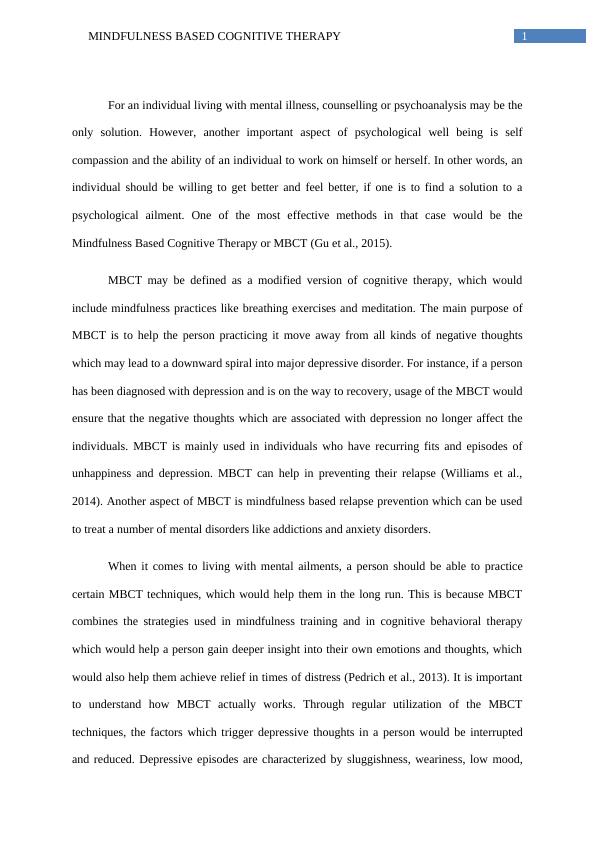Mindfulness Based Cognitive Therapy
Added on 2023-05-30
6 Pages1286 Words281 Views
Running head: MINDFULNESS BASED COGNITIVE THERAPY
Mindfulness based cognitive therapy
Name of student
Name of university
Mindfulness based cognitive therapy
Name of student
Name of university

1MINDFULNESS BASED COGNITIVE THERAPY
For an individual living with mental illness, counselling or psychoanalysis may be the
only solution. However, another important aspect of psychological well being is self
compassion and the ability of an individual to work on himself or herself. In other words, an
individual should be willing to get better and feel better, if one is to find a solution to a
psychological ailment. One of the most effective methods in that case would be the
Mindfulness Based Cognitive Therapy or MBCT (Gu et al., 2015).
MBCT may be defined as a modified version of cognitive therapy, which would
include mindfulness practices like breathing exercises and meditation. The main purpose of
MBCT is to help the person practicing it move away from all kinds of negative thoughts
which may lead to a downward spiral into major depressive disorder. For instance, if a person
has been diagnosed with depression and is on the way to recovery, usage of the MBCT would
ensure that the negative thoughts which are associated with depression no longer affect the
individuals. MBCT is mainly used in individuals who have recurring fits and episodes of
unhappiness and depression. MBCT can help in preventing their relapse (Williams et al.,
2014). Another aspect of MBCT is mindfulness based relapse prevention which can be used
to treat a number of mental disorders like addictions and anxiety disorders.
When it comes to living with mental ailments, a person should be able to practice
certain MBCT techniques, which would help them in the long run. This is because MBCT
combines the strategies used in mindfulness training and in cognitive behavioral therapy
which would help a person gain deeper insight into their own emotions and thoughts, which
would also help them achieve relief in times of distress (Pedrich et al., 2013). It is important
to understand how MBCT actually works. Through regular utilization of the MBCT
techniques, the factors which trigger depressive thoughts in a person would be interrupted
and reduced. Depressive episodes are characterized by sluggishness, weariness, low mood,
For an individual living with mental illness, counselling or psychoanalysis may be the
only solution. However, another important aspect of psychological well being is self
compassion and the ability of an individual to work on himself or herself. In other words, an
individual should be willing to get better and feel better, if one is to find a solution to a
psychological ailment. One of the most effective methods in that case would be the
Mindfulness Based Cognitive Therapy or MBCT (Gu et al., 2015).
MBCT may be defined as a modified version of cognitive therapy, which would
include mindfulness practices like breathing exercises and meditation. The main purpose of
MBCT is to help the person practicing it move away from all kinds of negative thoughts
which may lead to a downward spiral into major depressive disorder. For instance, if a person
has been diagnosed with depression and is on the way to recovery, usage of the MBCT would
ensure that the negative thoughts which are associated with depression no longer affect the
individuals. MBCT is mainly used in individuals who have recurring fits and episodes of
unhappiness and depression. MBCT can help in preventing their relapse (Williams et al.,
2014). Another aspect of MBCT is mindfulness based relapse prevention which can be used
to treat a number of mental disorders like addictions and anxiety disorders.
When it comes to living with mental ailments, a person should be able to practice
certain MBCT techniques, which would help them in the long run. This is because MBCT
combines the strategies used in mindfulness training and in cognitive behavioral therapy
which would help a person gain deeper insight into their own emotions and thoughts, which
would also help them achieve relief in times of distress (Pedrich et al., 2013). It is important
to understand how MBCT actually works. Through regular utilization of the MBCT
techniques, the factors which trigger depressive thoughts in a person would be interrupted
and reduced. Depressive episodes are characterized by sluggishness, weariness, low mood,

2MINDFULNESS BASED COGNITIVE THERAPY
fatigue, negative thoughts and other such symptoms. Using meditation and mindfulness
techniques would thus be beneficial for the person living with mental illness (Kuyken et al.,
2016).
The two main methods which can prove to be effective in MBCT would be meditation
and mindfulness breathing techniques. One of the major advantages of using meditation as a
technique is that it has no harmful side effects, which some drugs may have (Kuyken et al.,
2015). The patient would simply have to learn the techniques from an expert and the repeat
the same at home. Brooding, anxiety and stress are some of the major causes of depression.
Meditating would ensure that these negative thoughts pass by quickly and do not stick
around. It would also prevent brooding and instill more positive thoughts in an individual.
During meditation, a person is expected to sit still, with his eyes closed and concentrate on
the rhythm and pattern of his breathing. Focusing simply on the breathing, instead on the
various negative thoughts which may lead to depression. Concentrating on the rhythm of
breathing would result in a feeling of detachment, which would help one gain composure. It
would help the person realize that negative thoughts usually tend to come and go and there is
no need to brood over them (Khoury et al., 2013).
One of the major problems with depression and similar mental ailments is that it takes
up a major portion of one’s attention. A person who is suffering from a major depressive
disorder is likely to believe that only bad things happen to them and that they are incapable of
making progress. Such negative thoughts clouding one’s mind could lead to brooding and
fixating on one problem, which would further deepen the issue. However, breathing and
focusing on the breathing pattern would ensure that a person is able to concentrate on
something apart from the aforementioned negative thoughts (Van der Velden et al., 2015). It
would also ensure that the person is able to view his emotions and thoughts from a different,
objective perspective, which would provide him or her with better insight.
fatigue, negative thoughts and other such symptoms. Using meditation and mindfulness
techniques would thus be beneficial for the person living with mental illness (Kuyken et al.,
2016).
The two main methods which can prove to be effective in MBCT would be meditation
and mindfulness breathing techniques. One of the major advantages of using meditation as a
technique is that it has no harmful side effects, which some drugs may have (Kuyken et al.,
2015). The patient would simply have to learn the techniques from an expert and the repeat
the same at home. Brooding, anxiety and stress are some of the major causes of depression.
Meditating would ensure that these negative thoughts pass by quickly and do not stick
around. It would also prevent brooding and instill more positive thoughts in an individual.
During meditation, a person is expected to sit still, with his eyes closed and concentrate on
the rhythm and pattern of his breathing. Focusing simply on the breathing, instead on the
various negative thoughts which may lead to depression. Concentrating on the rhythm of
breathing would result in a feeling of detachment, which would help one gain composure. It
would help the person realize that negative thoughts usually tend to come and go and there is
no need to brood over them (Khoury et al., 2013).
One of the major problems with depression and similar mental ailments is that it takes
up a major portion of one’s attention. A person who is suffering from a major depressive
disorder is likely to believe that only bad things happen to them and that they are incapable of
making progress. Such negative thoughts clouding one’s mind could lead to brooding and
fixating on one problem, which would further deepen the issue. However, breathing and
focusing on the breathing pattern would ensure that a person is able to concentrate on
something apart from the aforementioned negative thoughts (Van der Velden et al., 2015). It
would also ensure that the person is able to view his emotions and thoughts from a different,
objective perspective, which would provide him or her with better insight.

End of preview
Want to access all the pages? Upload your documents or become a member.
Related Documents
Intervention for trauma PDFlg...
|3
|459
|148
Non-Pharmacological Therapies for Major Depressive Disorderslg...
|10
|2619
|27
Depression Mood Disorder | Assignmentlg...
|16
|3551
|313
ABNORMAL PSYCHOLOGY 4 ABNORMAL PSYCHOLOGY 1 Abnormal Psychologylg...
|5
|1173
|71
Nursing Assignment on Panic Disorder and Mindfulness Therapylg...
|5
|917
|348
(Doc) Defining mental health and mental illnesslg...
|12
|4497
|35
